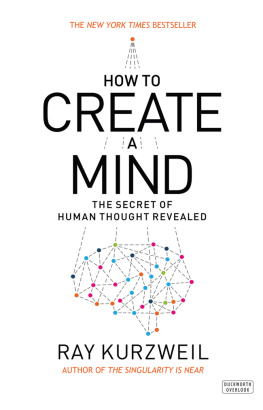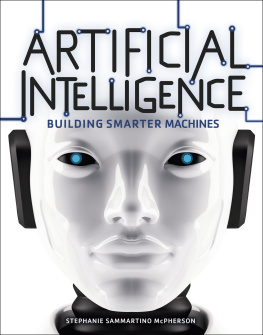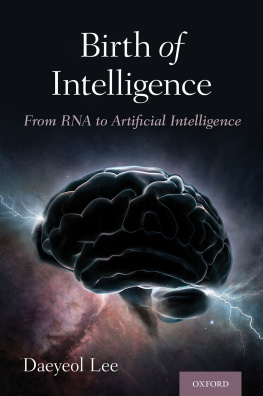Table of Contents
Praise for The Age of Spiritual Machines
The Age of Spiritual Machines ranges widely over such juicy topics as entropy, chaos, the big bang, quantum theory, DNA computers, quantum computers, Godels theorem, neural nets, genetic algorithms, nanoengineering, the Turing test, brain scanning, the slowness of neurons, chess playing programs, the Internetthe whole world of information technology past, present, and future. This is a book for anyone who wonders where human technology is going next.
The New York Times Book Review
A mind-expanding account of the rise of intelligent machines..... Nothing less than a blueprint for how to shove Homo sapiens off centre-stage in evolutions endless play.... If you buy into [Kurzweils Law of Accelerating Returns]and all empirical evidence currently available supports it completelythen the replacement of humans by machines as the primary intellectual force on Earth is indeed imminent.
John Casti, Nature
A welcome challenge to beliefs we hold dear ... Kurzweil paints a tantalizingand sometimes terrifyingportrait of a world where the line between humans and machines has become thoroughly blurred.
Chet Raymo, The Boston Globe
Brilliant ... Kurzweil clearly takes his place as a leading futurist of our time. He links the relentless growth of our future technology to a universe in which Artificial Intelligence and Nanotechnology combine to bring unimaginable wealth and longevity, not merely to our descendants, but to some of those living today.
Marvin Minsky, Professor of Media Arts and Sciences, MIT
The Age of Spiritual Machines makes all other roads to the computer future look like goat paths in Patagonia.
George Gilder, author of Wealth and Poverty and Life After Television
A compelling vision of the future from one of our nations leading innovators. Kurzweil brings serious science and a twinkling sense of humor to the question of where we are headed ... With his pioneering inventions, and his penetrating ideas, Kurzweil convincingly takes us through what promises to be the most pivotal of centuries.
Mike Brown, Chairman of the Nasdaq Stock Market
An extremely provocative glimpse into what the next few decades may well hold ... Kurzweils broad outlook and fresh approach make his optimism hard to resist.
Kirkus Reviews
ABOUT THE AUTHOR
Ray Kurzweils inventions include reading machines for the blind, music synthesizers used by Stevie Wonder and many others, and marketing leading speech-recognition technology. He is the author of The Age of Intelligent Machines, which won the Association of American Publishers Award for the Most Outstanding Computer Science Book of 1990, and The 10% Solution for a Healthy Life. He was awarded the Dickson Prize, Carnegie Mellons top science prize, in 1994. The Massachusetts Institute of Technology named him Inventor of the Year in 1988. He is also the recipient of nine honorary degrees and honors from two U.S. presidents. Kurzweil lives in a suburb of Boston.
A NOTE TO THE READER
As a photon wends its way through an arrangement of glass panes and mirrors, its path remains ambiguous. It essentially takes every possible path available to it (apparently these photons have not read Robert Frosts poem The Road Not Taken). This ambiguity remains until observation by a conscious observer forces the particle to decide which path it had taken. Then the uncertainty is resolvedretroactivelyand it is as if the selected path had been taken all along.
Like these quantum particles, youthe readerhave choices to make in your path through this book. You can read the chapters as I intended them to be read, in sequential order. Or, after reading the Prologue, you may decide that the future cant wait, and you wish to immediately jump to the chapters in Part III on the twenty-first century (the table of contents on the next pages offers a description of each chapter). You may then make your way back to the earlier chapters that describe the nature and origin of the trends and forces that will manifest themselves in this coming century. Or, perhaps, your course will remain ambiguous until the end. But when you come to the Epilogue, any remaining ambiguity will be resolved, and it will be as if you had always intended to read the book in the order that you selected.
ACKNOWLEDGMENTS
I would like to express my gratitude to the many persons who have provided inspiration, patience, ideas, criticism, insight, and all manner of assistance for this project. In particular, I would like to thank:
My wife, Sonya, for her loving patience through the twists and turns of the creative process
My mother for long engaging walks with me when I was a child in the woods of Queens (yes, there were forests in Queens, New York, when I was growing up) and for her enthusiastic interest in and early support for my not-always-fully-baked ideas
My Viking editors, Barbara Grossman and Dawn Drzal, for their insightful guidance and editorial expertise and the dedicated team at Viking Penguin, including Susan Petersen, publisher; Ivan Held and Paul Slovak, marketing executives; John Jusino, copy editor; Betty Lew, designer; Jariya Wanapun, editorial assistant, and Laura Ogar, indexer
Jerry Bauer for his patient photography
David High for actually devising a spiritual machine for the cover
My literary agent, Loretta Barrett, for helping to shape this project
My wonderfully capable researchers, Wendy Dennis and Nancy Mulford, for their dedicated and resourceful efforts, and Tom Garfield for his valuable assistance
Rose Russo and Robert Brun for turning illustration ideas into beautiful visual presentations
Aaron Kleiner for his encouragement and support
George Gilder for his stimulating thoughts and insights
Harry George, Don Gonson, Larry Janowitch, Hannah Kurzweil, Rob Pressman, and Mickey Singer for engaging and helpful discussions on these topics
My readers: Peter Arnold, Melanie Baker-Futorian, Loretta Barrett, Stephen Baum, Bryan Bergeron, Mike Brown, Cheryl Cordima, Avi Coren, Wendy Dennis, Mark Dionne, Dawn Drzal, Nicholas Fabijanic, Gil Fischman, Ozzie Frankell, Vicky Frankell, Bob Frankston, Francis Ganong, Tom Garfield, Harry George, Audra Gerhardt, George Gilder, Don Gonson, Martin Greenberger, Barbara Grossman, Larry Janowitch, Aaron Kleiner, Jerry Kleiner, Allen Kurzweil, Amy Kurzweil, Arielle Kurzweil, Edith Kurzweil, Ethan Kurzweil, Hannah Kurzweil, Lenny Kurzweil, Missy Kurzweil, Nancy Kurzweil, Peter Kurzweil, Rachel Kurzweil, Sonya Kurzweil, Jo Lernout, Jon Lieff, Elliot Lobel, Cyrus Mehta, Nancy Mulford, Nicholas Mullendore, Rob Pressman, Vlad Sejnoha, Mickey Singer, Mike Sokol, Kim Storey, and Barbara Tyrell for their compliments and criticisms (the latter being the most helpful) and many invaluable suggestions
Finally, all the scientists, engineers, entrepreneurs, and artists who are busy creating the age of spiritual machines.
PROLOGUE: AN INEXORABLE EMERGENCE
The gambler had not expected to be here. But on reflection, he thought he had shown some kindness in his time. And this place was even more beautiful and satisfying than he had imagined. Everywhere there were magnificent crystal chandeliers, the finest handmade carpets, the most sumptuous foods, and, yes, the most beautiful women, who seemed intrigued with their new heaven mate. He tried his hand at roulette, and amazingly his number came up time after time. He tried the gaming tables, and his luck was nothing short of remarkable: He won game after game. Indeed his winnings were causing quite a stir, attracting much excitement from the attentive staff, and from the beautiful women.

















